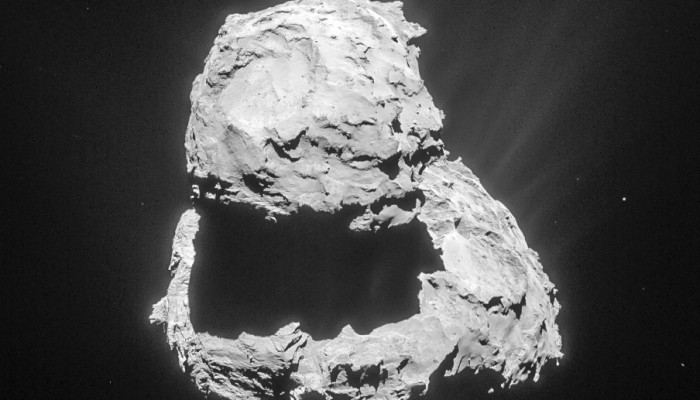
Scientists working on the European Space Agency (ESA) Rosetta Mission provided an update on the comet-chaser and its lander, Philae, at the European Geosciences Union (EGU) General Assembly last week, as well as sharing new science gained from the duo so far. These new results from Rosetta were announced at a press conference on Tuesday 14 April, with additional research presented at the Rosetta scientific session on Monday and Tuesday. Nikita Marwaha reports on some of these new developments revealed in Vienna.
The team started by reporting on the flightpath of the Rosetta spacecraft: it is currently keeping its distance from Comet 67P/Churyumov-Gerasimenko in an attempt to avoid streams of dust from interfering with its systems. The spacecraft is currently flying in a new orbital trajectory around the comet, following problems that arose when it made a Valentine’s Day flyby. Soaring just 6 km above the comet’s surface, the spacecraft’s star trackers, which enable it to navigate, “were getting confused” by dust close to the comet, said Matt Taylor, Rosetta Project Scientist at ESA.
Last month, Rosetta was forced into safe mode following another flyby which resulted in its navigation systems being compromised once more. As a result, the spacecraft had to rapidly retreat to a distance of 200 km. Taylor commented, “It turns out, it’s actually quite difficult to fly a spacecraft around a comet”.
His team are trying to calculate a safe approach distance for Rosetta to fly around the comet, with the craft currently alternating between pyramid orbits and terminator orbits. These new trajectories fly at a distance of 140 km and then 100 km and will allow the scientists to monitor how the spacecraft behaves before moving closer.
As the comet approaches perihelion – the orbital point closest to the sun – during the summer months, even more dust will stream out from it as it warms up and grows its characteristic tail. Meanwhile, the Rosetta spacecraft is slowly inching closer to its comet companion as scientists keep a watchful eye on it to ensure that its navigation systems are coping well.
Mission scientists also revealed their assessment on the potential existence of a magnetic field in the comet. Sensitive magnetometers on board both Rosetta and its lander Philae, which was dropped on to the surface last November, have collected measurements of their local environment. These instruments could sense not only the magnetic field carried in the solar wind flowing off the Sun, but also their interactions with it as they moved.
Such data from Rosetta and Philae suggests that Comet 67/P/Churyumov-Gerasimenko does not possess a magnetic field of its own. This finding is significant because it answers one of the major questions of the mission – did magnetic fields play a role in pulling together the material that makes up comets like 67P? This evidence suggests it did not.

An artist’s impression of Philae detaching from the Rosetta spacecraft. Scientists are currently trying to work out a safe distance from which Rosetta can orbit the comet, whilst waiting for Philae to wake up from hibernation. (Credits: ESA)
Other formation processes may have played a significant role in the birth of the early Solar System. Combined measurements from both orbiter and lander such as these provide us with a key insight into the primordial Solar System, and will produce further fruitful results once Philae wakes up from hibernation.
Locating the sleeping lander is a task in progress. It touched down very close to its target point last November, however then bounced to where it lies today. Rosetta scientists explained in the press conference that they have a good understanding of where the lander is but cannot identify it clearly from Rosetta’s imaging system, OSIRIS. They know that Philae is currently surrounded by walls and is sitting in a very dark area, riddled with shadows.
Questions still remain on the lander’s current orientation, why its footprints do not fit the landing gear geometry, why it bounced in a sharp angle and whether its feet hit rock or soft material when landing. Unfortunately, the illumination in the final landing site is very poor, with 1 hour and 20 minutes of sunlight per comet day. As a result, Philae is still in hibernation but scientists are optimistic that it will wake up within the next few weeks.
Stephen Ulamec, Philae Project Manager at German Aerospace Center (Deutsches Zentrum für Luft- und Raumfahrt; DLR) said, “In order to wake up, Philae’s solar panels should be sufficient to reboot the lander in the coming weeks”.
He also explained that a series of wake-up campaigns were already being launched, with the last attempt two days prior to the press conference. These campaigns involve periodically switching on Rosetta’s communication unit around the clock, so that once Philae gathers enough energy, its signal will be heard by the orbiter overhead. So far, there has been no contact made with the lander but as the comet approaches the sun, the scientists displayed hope for better news in time.
When asked what Philae waking up would mean to him, Matt Taylor said “Philae waking up is a fundamental part of the story. I see the Rosetta Mission as a kind of a soap opera and Philae is currently the cliffhanger. This can’t be the end.”
Rosetta has gripped the world with its fascinating story. This next stage of the mission is vital to unlocking the secrets of the primordial Solar System, yet for now we must wait patiently for Philae to wake up and join Rosetta in their quest to explore their new rocky world.
By Nikita Marwaha, EGU Press Assistant and EJR-Quartz Editor

Pingback: A Week in Vienna: The European Geosciences Union General Assembly | Making Apple Pie From Scratch